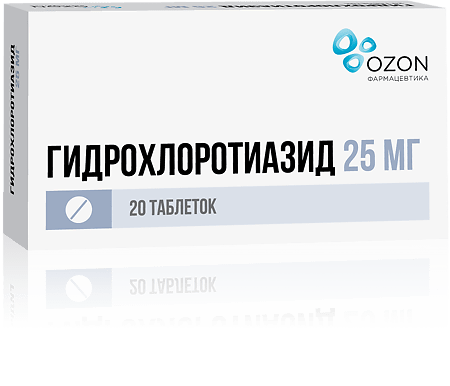No products in the cart.
Hydrochlorothiazide, tablets 25 mg 20 pcs
€1.96 €1.78
Description
Diuretic. The primary mechanism of action of thiazide diuretics is to increase diuresis by inhibiting reabsorption of sodium and chlorine ions in the initial part of the renal tubules. This leads to increased excretion of sodium and chlorine and, consequently, water. The excretion of other electrolytes, namely potassium and magnesium, also increases. At maximum therapeutic doses, the diuretic/natriuretic effect of all thiazides is approximately the same.
Natriuresis and diuresis occur within 2 h and reach maximum levels after approximately 4 h.
The thiazides also reduce carboanhydrase activity by increasing excretion of bicarbonate ions, but this effect is usually weak and has no effect on urine pH.
Hydrochlorothiazide also has hypotensive properties. Thiazide diuretics do not affect normal BP.
Indications
Indications
Treatment of hypertension – monotherapy or combination with other antihypertensive drugs;
of various origins (with acute and chronic, CHF, premenstrual syndrome, during treatment with corticosteroids and toxicosis of pregnant women); edema-nephrotic syndrome, renal failure
nephrogenic diabetes insipidus (control of polyuria).
Pharmacological effect
Pharmacological effect
Diuretic. The primary mechanism of action of thiazide diuretics is to increase diuresis by inhibiting the reabsorption of sodium and chloride ions in the initial part of the renal tubules. This leads to increased excretion of sodium and chlorine and therefore water. The excretion of other electrolytes, namely potassium and magnesium, also increases. At maximum therapeutic doses, the diuretic/natriuretic effect of all thiazides is approximately the same.
Natriuresis and diuresis occur within 2 hours and reach maximum levels after approximately 4 hours.
Thiazides also reduce carbonic anhydrase activity by increasing the excretion of bicarbonate ions, but this effect is usually mild and does not affect urine pH.
Hydrochlorothiazide also has antihypertensive properties. Thiazide diuretics do not affect normal blood pressure.
Special instructions
Special instructions
Use with caution in patients with gout and diabetes.
In patients with renal failure, systematic monitoring of plasma concentrations of electrolytes and CC is necessary.
If signs of potassium deficiency appear, as well as with the simultaneous use of cardiac glycosides, corticosteroids and ACTH, the prescription of potassium supplements or potassium-sparing diuretics is indicated.
With long-term use, you should follow a diet rich in potassium.
The simultaneous use of diuretics with NSAIDs is not recommended.
Active ingredient
Active ingredient
Hydrochlorothiazide
Composition
Composition
Active ingredient:
hydrochlorothiazide 25 mg;
Excipients:
lactose monohydrate,
povidone,
cellulose,
corn starch,
magnesium stearate.
Contraindications
Contraindications
Severe renal dysfunction, liver failure, severe forms of gout and diabetes, increased sensitivity to sulfonamides.
Side Effects
Side Effects
Electrolyte imbalance
Hypokalemia, hypomagnesemia, hypercalcemia and hypochloremic alkalosis: dry mouth, thirst, irregular heart rhythm, mood or mental changes, cramps and muscle pain, nausea, vomiting, unusual tiredness or weakness. Hypochloremic alkalosis can cause hepatic encephalopathy or hepatic coma.
Hyponatremia: confusion, convulsions, lethargy, slow thinking, fatigue, excitability, muscle cramps.
Metabolic phenomena: hyperglycemia, glucosuria, hyperuricemia with the development of an attack of gout. Treatment with thiazides may reduce glucose tolerance, and latent diabetes mellitus may become manifest. When using high doses, serum lipid levels may increase.
From the gastrointestinal tract: cholecystitis or pancreatitis, cholestatic jaundice, diarrhea, sialadenitis, constipation, anorexia.
From the cardiovascular system and blood (hematopoiesis, hemostasis): arrhythmias, orthostatic hypotension, vasculitis; very rarely – leukopenia, agranulocytosis, thrombocytopenia, hemolytic anemia, aplastic anemia.
From the nervous system and sensory organs: dizziness, blurred vision (temporarily), headache, paresthesia.
Hypersensitivity reactions: urticaria, purpura, necrotizing vasculitis, Stevens-Johnson syndrome, respiratory distress syndrome (including pneumonitis and non-cardiogenic pulmonary edema), photosensitivity, anaphylactic reactions up to shock.
Other: decreased potency, impaired renal function, interstitial nephritis.
Interaction
Interaction
With the simultaneous use of antihypertensive drugs and non-depolarizing muscle relaxants, their effect is enhanced.
With the simultaneous use of barbiturates, diazepam, ethanol, the risk of developing orthostatic hypotension increases.
When used simultaneously with GCS, there is a risk of developing hypokalemia, as well as orthostatic hypotension.
When used simultaneously with ACE inhibitors (including captopril, enalapril), the antihypertensive effect is enhanced.
Severe arterial hypotension is possible, especially after taking the first dose of hydrochlorothiazide, apparently due to hypovolemia, which leads to a transient increase in the hypotensive effect of the ACE inhibitor.
The risk of kidney dysfunction increases. The development of hypokalemia cannot be excluded.
With the simultaneous use of oral hypoglycemic drugs, their effectiveness decreases.
With the simultaneous use of calcium and/or vitamin D supplements in high doses, hypercalcemia and the risk of developing metabolic acidosis are possible due to slower excretion of calcium in the urine under the influence of thiazide diuretics.
When used simultaneously with allopurinol, the risk of allergic reactions increases, especially in patients with impaired renal function.
When used simultaneously with digoxin, the risk of developing glycoside intoxication may increase.
When used simultaneously with indomethacin, piroxicam, naproxen, phenylbutazone, the hypotensive effect may be slightly reduced.
When used simultaneously with irbesartan, an additive hypotensive effect may develop.
When used simultaneously with carbamazepine, there are reports of the development of hyponatremia.
When used simultaneously with colestipol and cholestyramine, the absorption and diuretic effect of hydrochlorothiazide decreases.
When used simultaneously with lithium carbonate, the concentration of lithium salts in the blood may increase to a toxic level.
When used simultaneously with orlistat, the effectiveness of hydrochlorothiazide decreases, which can lead to a significant increase in blood pressure and the development of a hypertensive crisis.
When used simultaneously with sotalol, hypokalemia and the development of ventricular arrhythmia of the “pirouette” type are possible.
Storage conditions
Storage conditions
In a place protected from light, at a temperature not exceeding 25 °C. In sealed packaging.
Shelf life
Shelf life
3 years
Manufacturer
Manufacturer
Ozon, Russia
Additional information
| Shelf life | 3 years |
|---|---|
| Conditions of storage | In a light-protected place at a temperature not exceeding 25 °C. In hermetically sealed package. |
| Manufacturer | Ozon, Russia |
| Medication form | pills |
| Brand | Ozon |
Related products
Buy Hydrochlorothiazide, tablets 25 mg 20 pcs with delivery to USA, UK, Europe and over 120 other countries.















